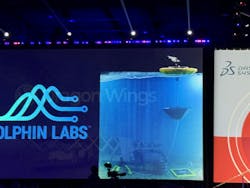Catching Waves for Renewable Energy
Sustainable energy is not only beneficial but essential, and ocean wave energy has emerged as a promising solution. Helping to chart this course is Chris Rauch, P.E., senior mechanical engineer, co-founder and now technical advisor at Dolphin Labs, a startup spinoff of CalWave Power Technologies Inc.
“The value of using wave energy is it’s renewable,” Rauch told Machine Design during an interview at Dassault Systemes’ 3DExperience World event in Houston in February. “You get more out of it in the same amount of weight than you do compared to solar or wind, so it's an amazing enabling technology that allows us to do more sensing than you can get out of a solar wind buoy.”
Dolphin Labs uses ocean wave energy to support an interconnected ocean. Their flagship product, the xNode buoy system—which was designed using the 3DExperience platform—is a wave energy converter that generates persistent, renewable electricity to enable remote ocean sensing networks, subsea microgrids and communications. This new class of expeditionary technology allows resident subsea technology to improve the safety, security and awareness of offshore natural resources and critical infrastructure.
Catching the Innovation Wave
Rauch’s journey into wave energy began at the young age of eight when he first caught waves down under. “I started surfing in Australia,” he said. “When we came back to the United States, we moved to Santa Cruz, Calif., where both of my parents grew up…So I’ve been in the ocean all my life.”
With his first-hand knowledge of how much power and energy there are in waves, he said he often wondered why nobody had done anything with that energy. Then when he was in graduate school studying naval architecture in a marine dynamics class, he said they talked about harnessing the energy from ocean waves. “How would you do that efficiently—with ocean waves not being consistent from hour to hour, minute to minute; they’re always changing? It makes for a very difficult and dynamic problem to solve,” he said.
Rauch’s background in naval architecture and marine dynamics facilitated his exploration of effectively harnessing this energy. “I’ve spent my career working in marine technology. A big portion of that was underwater robotics. I have a lot of experience putting hardware—mechanical hardware—in the ocean,” he said. His experience with hydrostatic pressures, seals, galvanic corrosion and bio fouling led him to get involved in the wave energy space. “I jumped at [the opportunity],” he said.
A New Kind of Energy Solution
Dolphin Labs focuses on smaller-scale applications that stand out in the renewable energy landscape. While CalWave provides grid scale power for communities, Dolphin Labs is innovating for remote sensing, capitalizing on the advantages of wave energy.
The xNode buoy platform is designed to be sensor-agnostic, allowing end-users to integrate various sensor types based on their specific needs. This adaptability ups the system’s functionality significantly, particularly for remote sensing tasks, which can be more energy intensive than traditional solar or wind solutions, according to Rauch.
The crux of Dolphin Labs technology lies in how it converts the energy from ocean waves into usable electrical power. The buoy system captures the up and down mechanical motion of waves and detangles the energy into electric output, Rauch explained. Unique to the design is the buoy’s deployment farther offshore where it can harness the consistent movement of waves without the interference of breaking waves near the shore.
One of the main technical hurdles is being able to take that mechanical motion and efficiently turn it into electricity. “And that is really the biggest challenge in this whole system,” he said. The variability complicates the mechanical-to-electrical conversion process, which the team is addressing by collaborating with academic institutions and private entities.
Engineering for Resilience
Dolphin Labs prioritizes durability in its designs—especially considering the harsh marine environments where the buoys will operate. Storms pose a significant threat to such systems, but the xNode’s design allows it to submerge beneath strong wave action, therefore reducing the risk of damage while continuing to generate energy, Rauch explained.
The system can operate either on the surface or submerged. “The way water wave mechanics work is you go down in the water; there’s actually this cone that comes together…there’s a rotary motion,” he said. “As you go down, the rotations get smaller.” The deeper the buoy is submerged, the less force there is.
“So we’re most efficient operating on the surface in the right sea state conditions,” Rauch added. As the waves get bigger, the xNode can go deeper and generate power while submerged, modulating how much force is being input to the system. The buoy needs to be close enough to the surface to feel the ocean wave influence. “But we don’t have to be right at the surface if we can’t mechanically handle it,” he noted.
Material selection plays a big role in the xNode’s longevity and reliability. The buoy’s hull is constructed from marine-grade 5083 aluminum with a design that includes sacrificial anode zinc to prevent galvanic corrosion. Rauch said other than the batteries, the materials are either recyclable or minimally harmful to the marine environment.
Regarding the batteries, he said, “We’re very specifically not using lithium ion batteries, because they have a lot of safety risks.” Instead they are looking at LFP, or lithium iron phosphate, batteries. They aren’t as energy-dense, but since it is not a mobile platform like an uncrewed underwater vehicle (UUV) or autonomous underwater vehicle (AUV)—where weight and endurance are critical—it’s less of a concern for them, Rauch explained, adding, “And given that we can produce energy as we go, lithium ion phosphate is a much better choice for us.”
A pressure vessel houses electronics and batteries in a controlled, dry environment, and power is transferred through sealed systems. Rauch said that for the last two decades he has explored various materials and manufacturing methods, noting there’s no perfect cost-effective solution. He said that weight is a key consideration—lighter structures allow for more batteries, which increases energy storage and system uptime. Because wave power isn’t constant, the system needs enough battery capacity to operate during calm periods. While current systems are stationary, the patented design includes future plans for mobile systems that can move to areas with more wave activity.
Applications for the Buoy System
The xNode has potential use in defense applications as it is an anchored, autonomous surveillance system equipped with visual cameras and acoustic sensors. It’s designed to continuously monitor ocean activity.
One example Rauch gave was for detecting unauthorized fleets—often large fishing vessels, sometimes with naval escorts—that enter territorial waters and deplete local fish stocks. Unlike manned aircraft patrolling vast areas, this stationary system can detect anomalies in real-time, gather and relay data quickly to command centers, and enhance maritime situational awareness—especially around sensitive areas like Navy bases—without requiring constant human presence, he said.
With a focus on bringing their prototypes to market, Rauch says that Dolphin Labs aims to deploy the xNode by the end of Q3 2025. With existing funding from government initiatives, including the Department of Energy, the path to commercialization appears promising, estimating a timeline of roughly two years to engage commercial customers.
Key Milestones for Dolphin Labs and xNode
2020: xNode wins the Nautilus Grand Prize in the NOAA-DOE Ocean Observing Prize (originally developed by CalWave).
2021-2022: CalWave completes a 10-month test of its x1 Wave Energy Converter with 99% uptime and zero interventions. The x1 featured the same winch-style drivetrain as the xNode, but at a larger scale.
Q4 2022: Dolphin Labs spins out from CalWave to focus exclusively on xNode development, securing exclusive IP access and engineering support from CalWave.
Q3 2023: Dolphin Labs partners with the U.S. Navy to develop and test xNode components, de-risking the platform for government customers.
Q3 2023: Awarded DOE Phase I SBIR to refine xNode for ocean observing applications.
H1 2024: Accepted into initial NATO DIANA cohort, one of 1,300 companies selected for the prestigious dual-use innovation accelerator. The program includes engagement with DIU, NSIN, NATO innovation leaders, and industry partners from 32 NATO member countries.
H1 2024: Successfully completes wave tank testing at University of Maine and Oregon State University, validating core system mechanics and model accuracy.
Q3 2024: Down-selected as one of 10 companies to advance into NATO DIANA GROW Phase, focused on funding, commercialization, and integration into the NATO ecosystem.
Q4 2024: Awarded U.S. Navy development contract for component and full prototype sea trial 2025.
Q4 2024: Awarded DOE Phase II SBIR to conduct a second sea trial to further advance xNode technology.
Q1 2025: One of seven Blue Economy startups selected for the Blue Action Lab Accelerator, unlocking:
- Market development support in the Blue Economy
- Strategic guidance on fundraising and investor positioning
- Operational and design input for real-world deployments and testing
About the Author
Sharon Spielman
Technical Editor, Machine Design
As Machine Design’s technical editor, Sharon Spielman produces content for the brand’s focus audience—design and multidisciplinary engineers. Her beat includes 3D printing/CAD; mechanical and motion systems, with an emphasis on pneumatics and linear motion; automation; robotics; and CNC machining.
Spielman has more than three decades of experience as a writer and editor for a range of B2B brands, including those that cover machine design; electrical design and manufacturing; interconnection technology; food and beverage manufacturing; process heating and cooling; finishing; and package converting.
Email: [email protected]
LinkedIn: @sharonspielman
Facebook: Machine Design
YouTube: @MachineDesign-EBM




